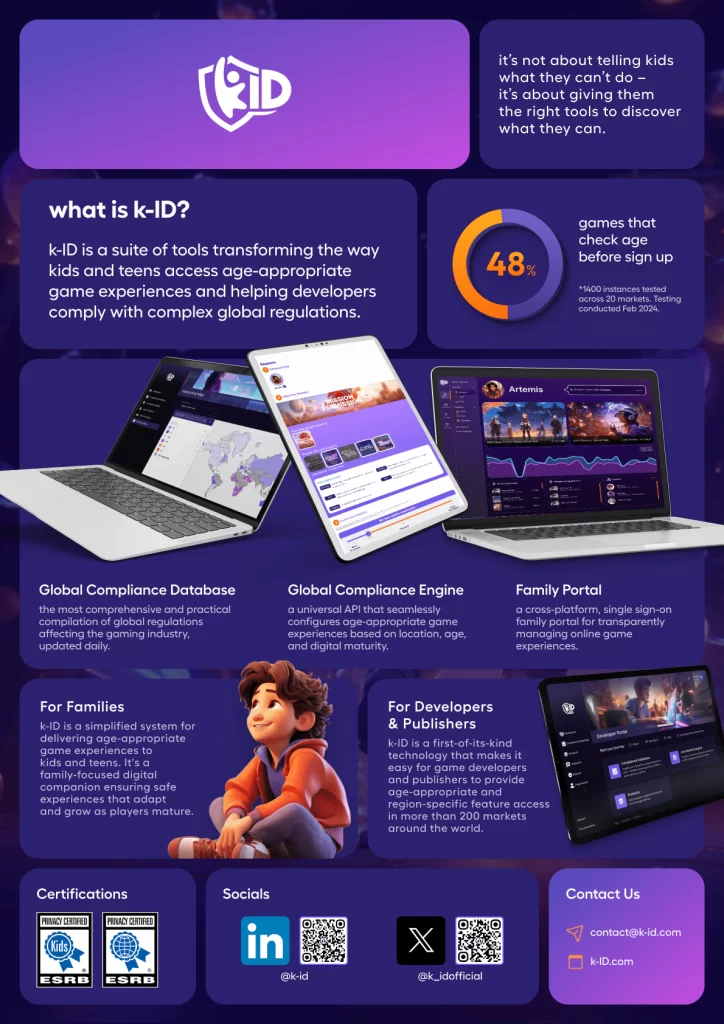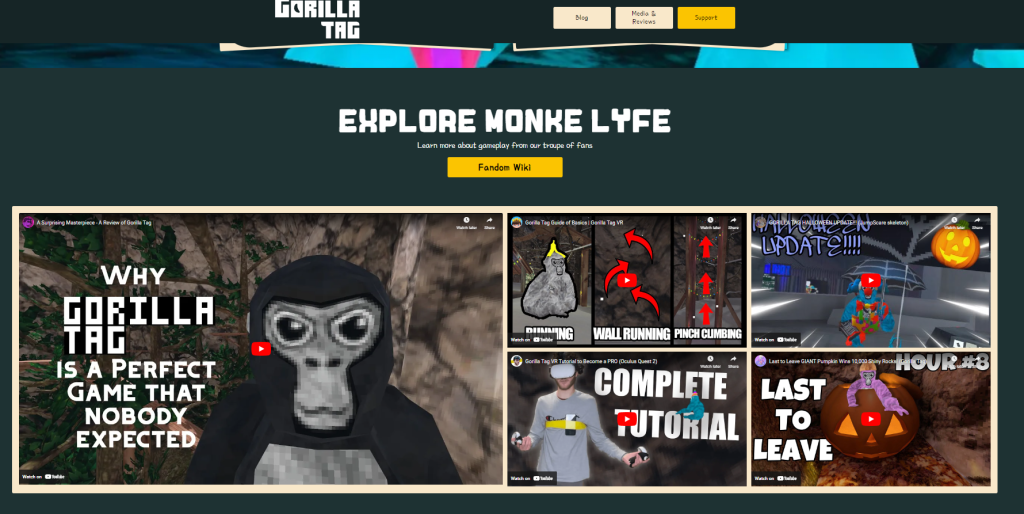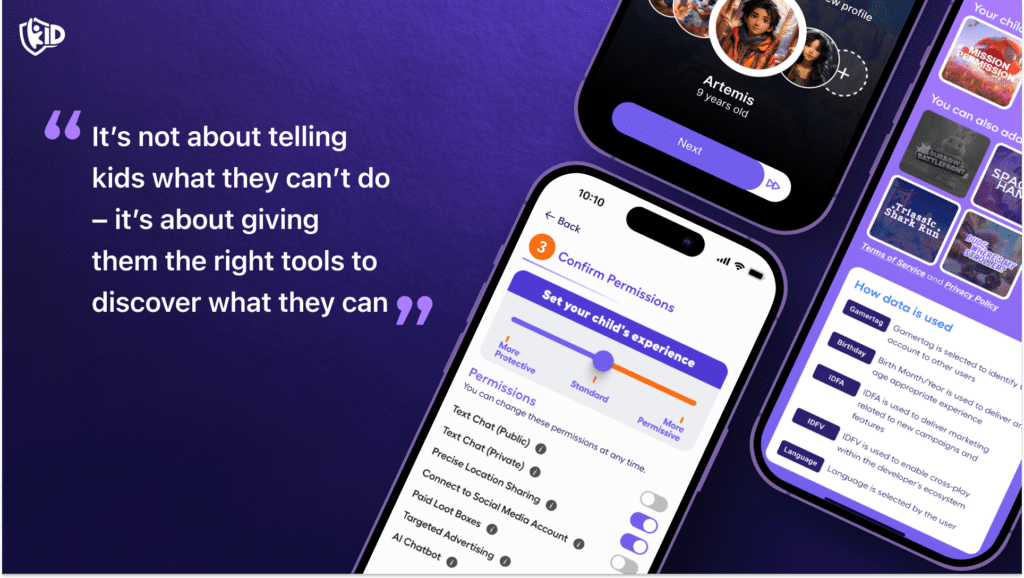Video games are often regarded as an activity primarily for children. However, the industry has exploded to reach all demographics. An older sophisticated audience demands mature content. Furthermore, many games are played online which opens a Pandora’s Box of privacy and safety concerns for all demographics, but especially for today’s digital youth.
To protect children, governments around the world have passed legislation regulating online activities for children (in some cases this can be up to the age of 21). Video game makers, like many content creators, walk a fine line between providing a mature experience while making sure they do not run foul of any government regulations regarding their younger audience.
Today it was announced that stealth startup k-ID had closed a $45 million from investors to bring to market its platform that focuses on ensuring video games are age appropriate. This was the third round of funding in less than a year bringing the total amount k-ID has raised to $51 million.
The concept behind k-ID is to create a platform that provides game developers tools to make games comply with global government regulation while also providing parents a universal, cross-platform means to control what their children are accessing.
From DFC Intelligence’s standpoint, k-ID is an interesting concept because it seems to be a solution that expands the global video game audience for many products. In other words, from a business perspective, it is a possible driver of greater revenue and profits. To find out more about what k-ID is doing DFC spoke with founder and CEO Kieran Donovan.

Give us an overview of k-ID. When were you founded, what is your broad purpose and motivation, what is the background of key team members?
We began the company nearly two years ago, but in many ways our founding team have been on this journey for over a decade each. Whether it be from a privacy, trust & safety, gaming, or technology perspective, we’ve each confronted the challenges involved in building safe and empowering experiences for kids (and teens).
In terms of our mission, the challenges confronting kids and teens online are well-publicized, but we focus on a specific area: how do we make it as easy as possible for developers to building experiences that comply with the complex regulation that impacts digital youth.
Today, outside of education, most of the internet is predicated on the idea that kids and teens are not online. That’s why you see so many pop-ups to “confirm you are over 13*”. (*12, 16, etc.)
Yet today’s youth are the most digitally native generation ever. This generation of youth and each generation subsequent will build more of their identity and community online, at an earlier age, and faster, than ever before.
Many aspects of the online world today are forced to be reactive to digital youth (the best example being that if a child “confirms they are over 13” and is later discovered, their account and identity is deleted). This can be the case even if in the real world their parent is in fact the one who helps them get online to begin with.
What we have built is the foundation for an internet that is proactive for a digitally native generation.
At the core of our philosophy is respect for the child and their rights. It is also about respecting the differences that can exist when building experiences for younger kids as compared with teens. It’s about respecting those youth where they are – not just importing rules from one jurisdiction and applying them everywhere but delivering an experience in line with the legal and cultural nuances of where they live. Finally, it’s about recognizing and accounting for the fact that not every 13-year-old is the same, and their digital maturity or vulnerability can vary wildly.
It seems that k-ID is focused on privacy, safety, and age-appropriate content. Can you explain why this is an issue and also the economic potential for developers who make the effort to implement k-ID?
Over the years, navigating regulatory environments has grown increasingly intricate—from the US to Brazil, Korea to the Middle East, each region has undergone significant regulatory changes. Today, perhaps no field is more complex than the regulation governing online activities for kids and teens. From chat functionalities to algorithms, content to the intricacies of loot boxes, and even the varying definitions of the age of digital consent (spanning from under 7 to under 21 depending on the jurisdiction), the landscape is multifaceted and challenging to navigate. That’s all to say, game compliance in particular is really complex – especially with so many different regulations that are constantly changing. And so far, everyone has been working on their individual solutions. In addition, managing any individual solution is also expensive, which means only the most well-funded companies can afford to create age-appropriate experiences, and even then those are often siloed.
The exciting part of implementing k-ID’s technology is that it opens up a developer’s game or platform to a youth audience in a safe way.

So we first heard about k-ID early this year. Yet at $51 million, you already have raised some major funding. How long have you been around and working on your technology? When will you be ready to go to market?
We’ve been circling this specific challenge for nearly a decade: how to build for youth online. We kicked off in earnest on ideating and then building the solution starting nearly two years ago. Over the past 12 months what has really changed is the increased pace of regulatory change (which has naturally meant more fragmentation around the world) combined with increased enforcement to the tune of hundreds of millions or billions of dollars in penalties.
Our technology supports all publishers, whether they are launching mobile free to play titles or AAA console titles. Our first live game will actually be the most popular VR title in the world, Gorilla Tag. We will be announcing this on Wednesday just after the press release about the Series A. You can include this in your coverage.

As we see it from our initial look, k-ID has three technologies. A Global Compliance Engine, a Global Compliance Database and a Family Platform. Can you tell us about each of these tools?
Think of the three as layers, each of which requires the one below it to function. The database is the brain – the collective knowledge of regulation and guidance from around the world. The engine is exactly that: an engine to power delivery of all of that knowledge directly into a game. And the family platform is the exciting part that we build on top to help parents meaningfully engage with gaming that their child or teenager isenjoying.
● k-ID Global Compliance Database is the most comprehensive and practical compilation of regulations affecting the gaming industry. Updated daily, it is the brainchild of industry experts who have managed compliance for global game launches and struggled with inefficient and costly processes for finding answers. Today, k-ID is leveraging insights from current and former regulators around the world while also working with the most sought-after youth and online safety organizations.
● k-ID Global Compliance Engine is a powerful, universal application programming interface (API) that seamlessly configures age-appropriate game experiences based on location, age, and digital maturity without friction or compromise. It is also US COPPA Safe Harbor certified through the Entertainment Software Ratings Board (ESRB), a unique recognition typically reserved for games themselves.
● k-ID Family Platform is a universal, cross-platform, single sign-on family portal for transparently managing online game experiences. In contrast to the lengthy onboarding that exists for kids and teens today, players instantly access integrated games, while parents go through a simplified process; adjusting the experience based on their player’s digital maturity. It reduces signing-up from dozens of steps to a few taps that take virtually seconds.

How much work needs to be done on the consumer end to use your technology? In terms of parents using k-ID for age-appropriate content is there a single sign-on or is this something that each developer does for their individual games?
It’s the fastest way to get online today for kids and parents.
For kids, it offers seamless instant sign-on capability, allowing a trusted guardian to unlock additional features by scanning a QR code. It also automatically tailors game features for both children and teenagers to comply with local regulations and cultural sensitivities. For parents, it serves as a unified console to efficiently manage and engagewith their child’s gaming activities.
What makes the k-ID approach and technology different from the competition? How were you able to stand out to investors?
The challenge that our technology solves — what can you do with a child once they arrive in an online world — is today solved with lawyers & engineers manually. We’re the first technology to actually take on the challenge of solving this automatically, instantly, and without adding friction to the user experience.
There are a lot of innovative things k-ID does, but something I’m personally pumped about is that we’re the only tool that manages kids and teens through their online journey from start to finish across platforms and accounts.
- k-ID simplifies the onboarding process for kids and teens, empowering them to actively engage in age-appropriate experiences and communities.
- k-ID offers parents peace of mind by offering easy-to-use features that parents can use to engage in their digital youth’s online journey across platforms.
- k-ID reduces sign-up times from dozens of steps to a few taps that take virtually seconds.
Every country has different regulations around age-appropriate content. In addition, laws regularly change. It seems this is a huge legal issue to deal with. How much effort does k-ID put on the legal side of the business?
This is what most of our team does every day. In some ways, we’re an odd-looking start-up: half of us are lawyers and half of the team are engineers. The reason for that is that we need to keep on top of the frenetic pace of change. We are also humbled to have an incredible network of people around the world, many of whom are former regulators, who help deliver unique insights into the database.
What is your business model? How do developers access and use your technology? Is there a charge to the consumer?
It’s very simple for developers and doesn’t take very long. They simply layer our API on top of their game. They don’t have to build it in so it’s very quick and easy. In terms of cost, we want to democratize access to safe, age-appropriate experiences online by providing an industry-wide, cross-platform solution that is cost-effective for all developers (big or small). There is no cost to use k-ID for parents and their kids.

